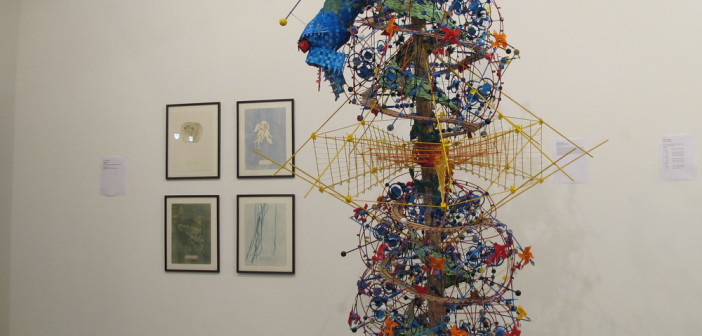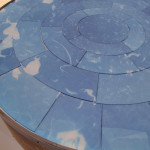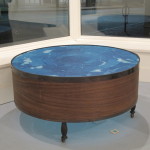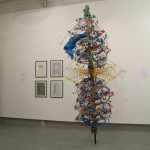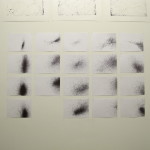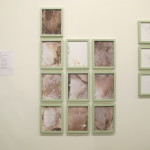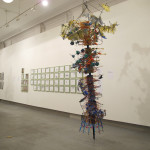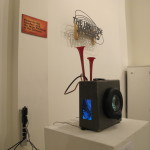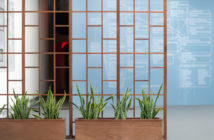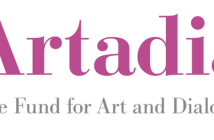When I heard the learn’d astronomer,
When the proofs, the figures, were ranged in columns before me,
When I was shown the charts and diagrams, to add, divide, and measure them,
When I sitting heard the astronomer where he lectured with much applause in the lecture-room,
How soon unaccountable I became tired and sick,
Till rising and gliding out I wander’d off by myself,
In the mystical moist night-air, and from time to time,
Look’d up in perfect silence at the stars.
- Walt Whitman, from Leaves of Grass, 1867
Space Gallery is looking up, down and within. This latest show, by guest curator Liz Sheehan, unites the work of artists Bartow+Metzgar, Jane D. Marsching, Nathalie Miebach, Deb Todd Wheeler, and The League of Imaginary Scientists. Like the Whitman excerpt which inspired its title, the exhibition brings together works that privilege an exploration of the world over mere consideration of its hard data, and remind us that science is the result of curiosity (bordering on mania), observation, patience, and time.
The works range from exquisite to playful to poetic, sometimes combining two or more of these qualities. Deb Tod Wheeler's stunning cyanotype panorama, Cypress and Star, occupies the bay window in the entrance to Space. Cyanotypes softened by tracing paper combine to depict strange translucent creatures, filaments and organisms, drawn by layered floating plastic. As is often the case when the term is used, calling Cypress and Star a "site-specific work" is a stretch. The object, round like a celestial chart, invites us to circle it and consider its illustrations from all angles. Inside the gallery, it is too close to the window to be walked around, which has the effect of diminishing it to a decorative piece of furniture rather than emphasizing its potential as a hypothetical scientific instrument. A minor complaint, perhaps, but all the more frustrating since nudging the object two feet into the space might resolve the problem.
Deb Todd Wheeler's Holoplanktonia is an discreetly humorous series of monotypes which mimic engravings of isolated plants underlined by their botanical names, except here the plants are born of plastic refuse and the names are Latinized nonsense, such as Polyamide Corpus Bulbosa. As in the cyanotype structure, these forms seems fragile and evanescent, belying the long and insidious life of plastics which break down into smaller and smaller parts but never disappear entirely.
Familiar with three of the artists in the show, the discoveries for me were Bartow+Metzgar and the group that makes up The League of Imaginary Scientists. The latter's contribution consisted of a video flanked by "a pseudo-interactive sculpture" meaning a sculpture that looks interactive but isn't, which was just annoying. It had a steam-punk flair mixed with a touch of Dr. Strangelove—mad folks in lab-coats. While playful, their contribution did little to clarify what the intent of the group might be. Make science fun, but to what end? Create artwork on the subject of science, but which aspect of science and why? Focusing almost entirely on the clown-like performance of fictionalized scientist-artist characters, the League's actions seem to suggest that science is a comedy of errors.
Bartow+Metzgar on the other hand conduct aesthetically simple experiments that yield mysterious and compelling results. The artists rig a pen to a tree and let the wind and the branch create a drawing in time. Or they bury vellum for up to a year and, upon exhumation, scan the resulting decay. These pieces contained the arbitrariness, the sense of time and patience involved in a scientific observation of the world.
Nathalie Miebach's recent sculptures attempt to map the ecosystems of the Gulf of Maine by weaving representations of tidal and seasonal time-frames, weather patterns and marine data into complex color-coded vertical structures. These pieces hold their own in the space, combining remarkable strength with lightness and movement. Miebach brings rigorous research and engaging aesthetics to her work—which sometimes suffers a little from the literalism data imposes on the sculptural form. But overall her work is effusive, carrying within in a playful delight in the scope and depth of nature.
In the interest of full disclosure, I recently co-curated an exhibition juxtaposing Jane D. Marsching's Ice-Out and If Wind Now with some of Miebach's earlier sculptures, and one of my reasons for traveling to Space was to discover another iteration of this pairing. It was a pleasure to see Marsching's recent work on Walden again in this context, particularly the elegant interpretation of wind data by dancer and choreographer Sarah Baumert. Translating data into movement meant Marsching and Baumert had to work on this dance on windless days, in order for the motion to most accurately mirror the impact of a gust, pause or breeze on the body.
Site-specific mystery solved! Deb Todd Wheeler had originally conceived of a window-mounted work but changed the mount to a table, as a prototype for a furniture project at Brandeis. The exhibition text had unfortunately not been edited to reflect this change.
- Deb Todd Wheeler Cypress and Star, 2012 photo: Stephanie Cardon
- Nathalie Miebach (foreground) Deb Todd Wheeler (background) photo: Stephanie Cardon
- Bartow+Metzgar photo: Stephanie Cardon
- Bartow+Metzgar photo: Stephanie Cardon
- Nathalie Miebach (foreground) Bartow+Metzgar (background) photo: Stephanie Cardon
- The League of Imaginary Scientists
When I Heard the Learn'd Astronomer is open until December 20, 2012
Space Gallery
538 Congress Street, Portland, ME 04101
(207) 828-5600
website

